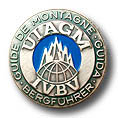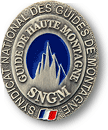 |
|
| New Zealand |
| Difficulty on
this page: |
The "Southern Alps" are known for their beauty and wild nature. Climbing here is serious, with often long approaches (helicopters are widely used), inclement weather, heavily crevassed glaciers, ice-clad summits, and spires and ridges of shattered rock. The truth is, these same wild qualities make the mountains of New Zealand known worldwide for holding some of the best alpine climbing to be found anywhere. Just as the conditions and difficulty of the climbing can be great, so can the rewards, with occasional perfect days in high and remote alpine ridges and faces. The weather of New Zealand is legendary. Days of rain can follow each other for a week at a time in the Mount Cook massif. Meanwhile other areas might be drier. The region around Mount Aspiring, for example, enjoys a slightly rain-shadowed location. For this reason we advise spending as much time as possible in the country, and being mobile and able to change climbing objectives as necessary. In February of 2000 and 2001 Kathy climbed in the Mount Cook massif with Andy Latham and Mike Christianson. and in 2003, Kathy and Mark spent a month and a half wandering around the South Island climbing one gem after another. The following suggested objectives are the result of these exploratory trips. There are also many rock climbing sites and other challenging peak ascents worth exploring in the South Island, especially if weather and conditions in the high mountains are not ideal. We therefore propose a tentative and flexible itinerary, planning to finalize our schedule around the current conditions and forecast. |
||||
|
||||||||
Pioneer and Centennial Huts: the Upper Fox and Franz Josef Glaciers Located on the windward side of the range, these huts take the brunt of westerly storms off the Tasman Sea, but in stable weather there is great climbing and training to be done from here. Dramatic and challenging Mount Tasman is accessible in a long day from the Pioneer hut, as are many smaller but technically interesting peaks along the divide to the north of Tasman and Cook: Mount Haast, Mount Haidinger, Douglas Peak, Glacier Peak, and many others. From the Centennial Hut Mount De la Beche and the Minarets are accessible, and a spectacular traverse can be done over De la Beche and down to the east to join the Tasman Glacier and the De la Beche hut. |
||||
 |
|
| Mount Conway | |
Upper Tasman Glacier The Tasman Glacier is an impressive valley glacier that flows for several miles below the east side of Mount Cook. At its source and northern extremity are two huts: the Kelman hut and the Tasman Saddle hut. This area is great for skills instruction and review, and ascents on glaciers, snow and ice. Staying at either of the two huts, one can do day-climbs of Hochstetter Dome, Mount Walter or Mount Green, or a longer ascent of Elie de Beaumont. Mixed and rock climbing can be done on nearby Mounts Annan, Abel or Darwin. |
||||
Mount Tasman Mount Tasman sits along the ridge immediately to the north of Mount Cook, competing with the latter for imposing domination of the Grand Plateau. Where Cook is massive and dark with rock, Tasman by contrast looks graceful and white with snow flutings and cornices. Tasman offers a scenic, exposed and beautiful route via the North Shoulder. The climb is long, and both technically and athletically demanding. It is approached from the upper Fox Glacier, typically from the Pioneer hut. |
||||
Mount Cook Early in the season, if you get lucky you might have a shot at Mount Cook via the Linda Glacier from the Plateau hut. The route involves moderate angled glacier slopes, with a traverse leading to rock and ice climbing on the steeper summit ridge. There is exposure to icefall on the traverse to the summit ridge. The hut is typically approached by helicopter (the Plateau hut is the only one on Mount Cook itself which can be accessed by flight service under Park Service regulations). In some years, conditions are not good for this route, with serious crevasse and icefall obstacles on the Linda Glacier, or rockfall hazard due to instability of the summit ridge. These conditions can exacerbated by warm temperatures and no nighttime freezing during the good weather periods. However, every year is different, and most years offer good conditions for at least part of the season. There are also alternative routes from the west, via the Empress hut. These routes are all considerably harder than the Linda Glacier, and involve a two-day approach. If you're interested in climbing Mount Cook, you should allow plenty of time, and be willing to change objectives if the conditions dictate. |
||||
 |
|
| Mount Earnslaw | |
Malte Brun Opposite Mount Cook on the east side of the Tasman Glacier, Malte Brun's West Ridge hosts a beautiful, long alpine rock route for the ambitious. |
||||
| Leaving the Mount Cook massif, several smaller ranges to the south contain worthwhile climbing objectives, particulary for the lover of alpine rock routes. Also nearby is Mount Aspiring, sitting rather more aloof and by itself, but beautiful in its own right. |
 |
Kathy Cosley & Mark Houston AMGA Certified • SNGM members All images, layout and text ©2004 Cosley & Houston Alpine Guides, All Rights Reserved |
|









